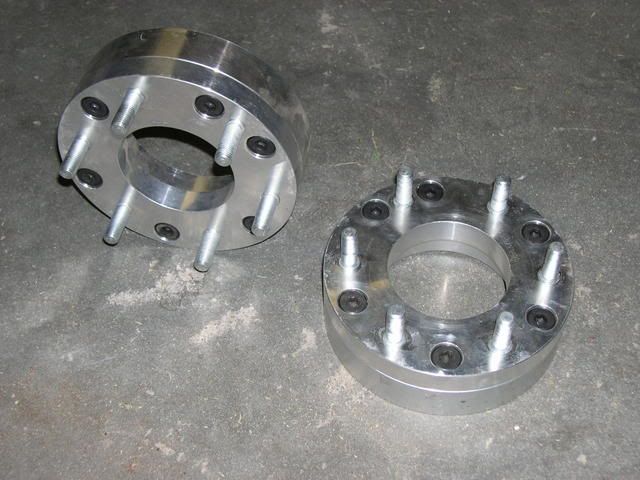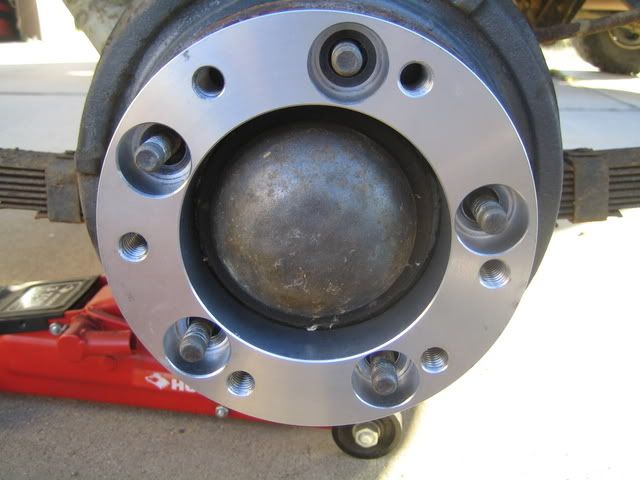2 piece wheel adapters?
#1
Thread Starter
Contributing Member
Joined: Dec 2005
Posts: 2,124
Likes: 0
From: Los Osos, CA (we can't agree on crap!)
2 piece wheel adapters?
I have a pair of 2 piece wheel adapters that I am going to use to change the bolt pattern on my m416 from 5on5.5 to 6on5.5 to match the yota. I bought these second hand (never used) but they didn't come with directions. I know from searching that for one piece spacers to use loctite. My question is Should I use loctite on the second piece that uses allen head bolts? I searched the internet and found a company that makes these and there site said to use anti-sieze on all the bolts not loctite. From Skulte Performance Products " Wheel Adapter FAQ
Should I use anti-seize on the studs? Won't it cause the lugnuts to loosen easier?
Definitely! A small dab of anti-seize on both the hub and adapters studs make torque values much more consistent, and prevent the lugnut from seizing after hard racing or a salty north-east winter. As you torque the lugnut to spec, the stud acts like a spring, and gets pre-loaded. This tension in the stud is what holds the lugnut tight against the wheel (or adapter). By lubricating the stud with anti-seize, you make sure the torque on the lugnut will go to tensioning the stud, rather than friction that does not increase the tension, and will make it easier to lose pre-load and loosen. As long as there is tension, the lugnut will not loosen.
Does this sound correct? I like the idea of not using loctite on the second piece because it needs to be removed to get to the hub and check the lug nuts on the first piece. Thanks for the help here are some pics of the adapters



Sorry for the long post but wanted to make sure I do this right.
Should I use anti-seize on the studs? Won't it cause the lugnuts to loosen easier?
Definitely! A small dab of anti-seize on both the hub and adapters studs make torque values much more consistent, and prevent the lugnut from seizing after hard racing or a salty north-east winter. As you torque the lugnut to spec, the stud acts like a spring, and gets pre-loaded. This tension in the stud is what holds the lugnut tight against the wheel (or adapter). By lubricating the stud with anti-seize, you make sure the torque on the lugnut will go to tensioning the stud, rather than friction that does not increase the tension, and will make it easier to lose pre-load and loosen. As long as there is tension, the lugnut will not loosen.
Does this sound correct? I like the idea of not using loctite on the second piece because it needs to be removed to get to the hub and check the lug nuts on the first piece. Thanks for the help here are some pics of the adapters



Sorry for the long post but wanted to make sure I do this right.
#3
Thread Starter
Contributing Member
Joined: Dec 2005
Posts: 2,124
Likes: 0
From: Los Osos, CA (we can't agree on crap!)
How hard is it to loosen them if I loctite them? I don't want to end up stripping the allen head when I take them off to get to the hub or to check the torque on the lugnuts.
#5
Chris,
Got your PM. On a trailer...not a big deal...but I'd NEVER use those on a vehicle...flat out. I'd just find the proper rim.
I would think you'd install those much like wheel spacers and since those socket heads won't take a breaker bar on them without stripping (which would be needed to bust red loc-tite), get an allen head socket (looks like about a 10mm or 3/8") and torque them to about 100 ft/lbs and use the anti-seize. Recheck and retorque after 100 miles.
If they were normal wheel spacers, I'd use loc-tite instead of anti-seize, but normal wheel spacers use all lug nuts and can take a bit of abuse to get them off.

Got your PM. On a trailer...not a big deal...but I'd NEVER use those on a vehicle...flat out. I'd just find the proper rim.
I would think you'd install those much like wheel spacers and since those socket heads won't take a breaker bar on them without stripping (which would be needed to bust red loc-tite), get an allen head socket (looks like about a 10mm or 3/8") and torque them to about 100 ft/lbs and use the anti-seize. Recheck and retorque after 100 miles.
If they were normal wheel spacers, I'd use loc-tite instead of anti-seize, but normal wheel spacers use all lug nuts and can take a bit of abuse to get them off.

#6
Thread Starter
Contributing Member
Joined: Dec 2005
Posts: 2,124
Likes: 0
From: Los Osos, CA (we can't agree on crap!)
Thanks wabbit, that is kind of what I was thinking, but wanted to check with the experts.
I think that is why the guy I bought them from sold them, he was going to run them on his rig. He didn't use them, he just test fit them and I'm sure he thought twice about useing them. Ended up getting a really good deal on them. thanks again,
I think that is why the guy I bought them from sold them, he was going to run them on his rig. He didn't use them, he just test fit them and I'm sure he thought twice about useing them. Ended up getting a really good deal on them. thanks again,
Thread
Thread Starter
Forum
Replies
Last Post
crashburnoveride
86-95 Trucks & 4Runners
1
07-10-2015 06:39 AM











